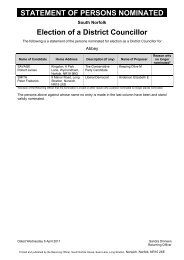Section 3: Place Making and Design Principles [PDF] - South Norfolk ...
Section 3: Place Making and Design Principles [PDF] - South Norfolk ...
Section 3: Place Making and Design Principles [PDF] - South Norfolk ...
You also want an ePaper? Increase the reach of your titles
YUMPU automatically turns print PDFs into web optimized ePapers that Google loves.
3.2.1 Community facilities<br />
Key principles<br />
A range of community facilities should be<br />
available within easy reach of places that<br />
people live <strong>and</strong> work, so that they can be<br />
accessed without needing to use the car.<br />
Why is it important?<br />
Successful places are about more than<br />
providing suitable housing <strong>and</strong> places of<br />
work for local people. They also need a<br />
range of social <strong>and</strong> community facilities<br />
to allow local people to interact with one<br />
another <strong>and</strong> to support daily life.<br />
Local community facilities help to:<br />
• establish a sense of local identity <strong>and</strong><br />
community;<br />
• encourage walking <strong>and</strong> cycling;<br />
• support residents well-being in terms<br />
of education, healthcare, shops,<br />
local services <strong>and</strong> employment, <strong>and</strong><br />
recreation;<br />
• create places where all members of<br />
the local community can meet one<br />
another.<br />
Are new facilities required?<br />
Local community facilities include a wide<br />
range of uses <strong>and</strong> activities, including<br />
schools, nurseries, shops, pubs <strong>and</strong><br />
cafes, local workspace, healthcare,<br />
community centre, parks <strong>and</strong> play<br />
areas <strong>and</strong> also a good broadb<strong>and</strong><br />
infrastructure network.<br />
In some cases there may be advantages<br />
to providing a single, multi-purpose<br />
community facility that can be used by<br />
different groups <strong>and</strong> agencies at different<br />
times of the day or week.<br />
It is important to identify whether new<br />
facilities are required or whether the<br />
proposed residents could access<br />
existing facilities <strong>and</strong> support their<br />
continued viability.<br />
For large-scale masterplans, local<br />
community consultation is essential to<br />
ensure that development will reflect<br />
local needs. However, proposals for<br />
community facilities must be realistic in<br />
terms of project viability, management<br />
<strong>and</strong> ownership.<br />
There is a balance to be struck between<br />
creating a new sense of place <strong>and</strong><br />
community in a new development <strong>and</strong><br />
supporting an existing place, which<br />
might also help promote the social<br />
integration of existing <strong>and</strong> new residents.<br />
Where should new facilities be<br />
placed?<br />
The position of new facilities in a new<br />
development may influence their use.<br />
At the heart of a new development, they<br />
may promote a sense of identity but<br />
they may also be seen as being for new<br />
residents only, whereas if they are sited<br />
towards the edge of a development they<br />
may be used by both new <strong>and</strong> existing<br />
residents.<br />
Where large scale urban extensions<br />
are proposed, it may be appropriate to<br />
create a new centre with facilities for<br />
the entire settlement, or alternatively<br />
to exp<strong>and</strong> an existing centre that is<br />
accessible <strong>and</strong> in need of revitalisation.<br />
Are local facilities accessible?<br />
Wherever possible new development<br />
should be within convenient walking<br />
or cycling distance of existing local<br />
facilities. Where new facilities are<br />
required they should be within walking<br />
distance of as many residents as<br />
possible (both new <strong>and</strong> existing<br />
residents), consistent with creating an<br />
appropriate site layout (assessed under<br />
3.3.2 Integrate with surroundings).<br />
Main Contents<br />
<strong>Section</strong> 3 Start<br />
3.1 Introduction<br />
3.2 Uses <strong>and</strong><br />
activities<br />
3.3 Accessibility<br />
3.4 Site assets<br />
3.5 Character<br />
3.6 Development<br />
form<br />
3.7 Public realm<br />
3.8 <strong>Design</strong><br />
quality<br />
3.9 Performance<br />
3.10 Worked<br />
example<br />
3.3.2<br />
Integrate with<br />
surroundings<br />
127


![Section 3: Place Making and Design Principles [PDF] - South Norfolk ...](https://img.yumpu.com/28189284/7/500x640/section-3-place-making-and-design-principles-pdf-south-norfolk-.jpg)
![List of outstanding appeals against planning decisions [PDF, 30 Kb]](https://img.yumpu.com/51294693/1/190x135/list-of-outstanding-appeals-against-planning-decisions-pdf-30-kb.jpg?quality=85)
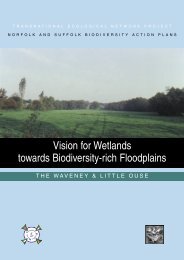
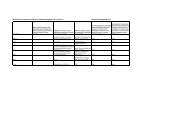
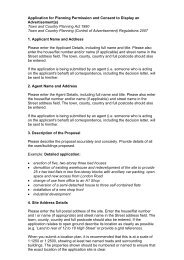
![Brown bin calendar - week 2 [PDF] - South Norfolk Council](https://img.yumpu.com/49352110/1/184x260/brown-bin-calendar-week-2-pdf-south-norfolk-council.jpg?quality=85)
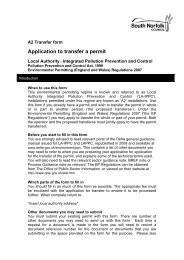

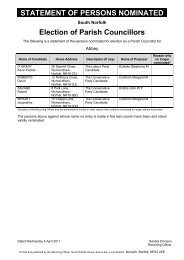
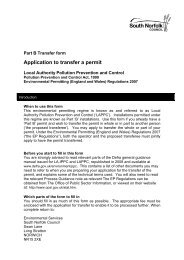
![Link magazine, Spring 2008 [PDF, 4,450k] - South Norfolk Council](https://img.yumpu.com/43994858/1/184x260/link-magazine-spring-2008-pdf-4450k-south-norfolk-council.jpg?quality=85)
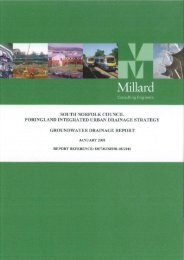
![South Norfolk Council Volunteering Opportunities [PDF]](https://img.yumpu.com/42079564/1/184x260/south-norfolk-council-volunteering-opportunities-pdf.jpg?quality=85)
![Tiffey Valley Guide [PDF, 1,450k] - South Norfolk Council](https://img.yumpu.com/41615145/1/124x260/tiffey-valley-guide-pdf-1450k-south-norfolk-council.jpg?quality=85)
![Queen's Diamond Jubilee Fund [PDF] - South Norfolk Council](https://img.yumpu.com/41088331/1/184x260/queens-diamond-jubilee-fund-pdf-south-norfolk-council.jpg?quality=85)
